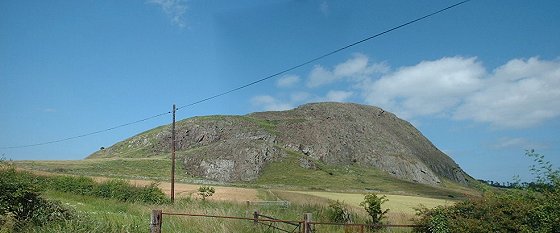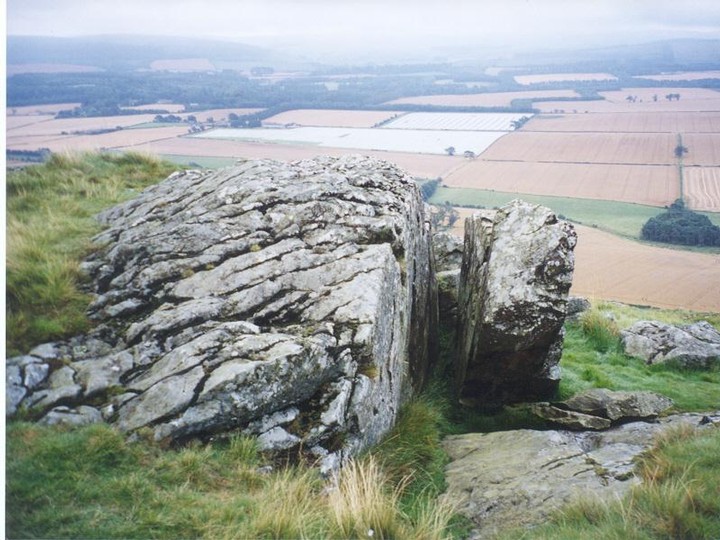Reflective Note I thought long and hard about where to
place my first cache. Little did I know when I placed it that I
would soon be living close by or that I would marry the person who
set the East Lothian caches I referenced on the cache page.
All of us have significant “firsts”. For a climber,
there is something special about the first lead. The first time she
or he is at the front end of a rope in the great outdoors. And my
first lead was The Vertical Ladder on the Lammer Wall at Traprain
Law in East Lothian on a balmy summer evening. The Ladder is one of
nearly 100 climbs crammed on to the two small rock faces on the
south side of this elegant whale backed hill. In the quirky British
system of grading climbs, the Ladder is “Very
Difficult”, which translates in practice as “about
as easy as it gets”! But I remember still the excitement of
working up through the blocky chimney and then, at the top, coming
out into the open and reaching round to the left into space with a
foot and a hand that did not know whether there was anything to
step onto/get hold of. There was. And I stepped out and up and
topped out and felt “on top of the world”. And
I’ve been searching for the same feeling on climbs ever
since.
You don’t have to climb the Vertical Ladder or any of the
other rock-climbing routes on Traprain Law to find this cache
– which is actually some way away from the cliffs. But you
should score extra points if you do! And even without climbing, you
are in the presence of historical, natural and mythological magic
wherever you go in this wonderful place.
Traprain Law lies south of the A1 and east of the town of
Haddington. Geologically, it is the eroded stub of a laccolith
– an intruded plug of volcanic rock that formed below the
surface 300 million years ago. Geographically, it is the biggest of
the isolated hills that dominate the east Lothian plain.
Historically, we are into overdrive – this is one of the most
important archaeological sites in lowland Scotland. The complex
archaeology is still being worked on but there are traces of man
from the earliest times. For reasons that will be completely
obvious when you walk it, the Law became an important centre of
habitation as soon as there were people in the area and remained a
key centre for 5 millenia, through the Neolithic period, the Bronze
and Iron ages and into and beyond the period of the Roman
occupation and its aftermath. And it is abundant in natural history
too. Among others, there are many and varied butterflies around the
field margins and plenty of rabbits supporting a resident
population of buzzards and of peregrine falcons (one of which has
taken to roosting on Fidra where there is a camera that feeds back
pictures of the roost to the Seabird Centre in North Berwick
– handily tying in connections to two more East Lothian cache
sites).
Historically, the Law was in permanent human occupation from the
time the first people made their way here. It became one of the two
main centres in lowland Scotland of the people the Romans called
the Votadini, and who called themselves the Gododin. The other
Votadini “capital” was the Dun of Edin – the
Castle Rock of Edinburgh (see Haggis Hunter’s Crag and
Tail). For most of the period the Law was by far the more
important of the two places.
The Votadini appear to have been important clients or allies of
the Romans and certainly not a subject people. A famous hoard of
Roman silver, known as the Traprain Treasure (now in the National
Museum of Scotland in Edinburgh) found on the Law in 1919 indicates
that the Romans were paying the Votadini well to act as a buffer
between Roman Britain and the more intractable peoples further
north.

Traprain Treasure
Later, as the Romans withdrew, the Votadini were a key part of
the struggle to retain the old Britain against the invasions of
Saxons and others from Europe and Ireland. The verse story of Y
Gododin about the period is one of the sources for the
Arthurian legends. But the eventual Saxon success is reflected in
some of the local place names, including Athelstaneford; which is
now one of many douce East Lothian villages but is also remembered
as the place where Scotland got its national flag, the Saltire,
from a cloud formation over yet another of the battlefields of our
bloody history.
Of course other mythology surrounds the Law. There are magic
stones on and around the hill. If you approach from the south you
can pass by the Lot or Loth Stane, supposedly marking the grave of
King Loth – who gave his name to Lothian. (The Lot
Stane now has its own cache: GCY3MW.) A Pictish king
around 518, Loth had a daughter called Thenew who fell in love with
a local shepherd. This didn't please Loth and he condemned his
daughter to death by having her thrown from the top of the Law. She
survived though and still unconscious was carried to a coracle and
set afloat on the Firth of Forth. The tide carried her to Culross,
where the still unconscious princess was taken ashore by shepherds.
Sometime after, she bore a son called Kentigern, who trained as a
holy man and was later called Mungo. When he grew up he travelled
west and set up a monastery in a small village called Cathures -
this grew into the great city of Glasgow, of which Mungo is the
patron saint. Thenew is now revered as St Enoch.
The shepherd who fell in love with Thenew took revenge on Loth
and killed him with an arrow through his heart and legend has it he
was buried at the foot of Traprain Law. Sir James Simpson (the one
who invented anesthesia) excavated around the Loth Stane trying to
find the grave and is reputed to have found an empty cist.

Traprain Law from the Lot Stane
On the Law itself you can pass through the cleft of the Maiden
Stane to ensure your fertility…as long as you squeeze
through naked, that is! (I have to confess that it has done nothing
for my fertility, which was surgically disenhanced many years
ago…)

The Maiden Stane
The mysteries continue into modern times as Traprain Law is now
reputed to be one of the centres of UFO activity in Scotland. (If
you see ET during your visit, tell him to not to phone home on that
bloody mobile…..This place doesn’t need that kind of
intrusion!)
Getting There
Climbers usually approach the south side of the Law through
Haddington, driving east through the town and over Victoria Bridge.
About 2km out of town, take the right turn signposted to Garvald
and Stenton. 3km further on take a left turn at a crossroads and
park at the side of the road just beyond a sharp right hand bend
around N55.57.555 W002.40.077 There is a path beside a field
to the cliffs via a large ladder stile; take care with any crops.
Once across the stile there are two cliffs ahead of you. To the
left is Overhang Wall, with the classic “Great
Corner” climb in the centre. The rock has been polished
by the hands and feet of generations of climbers and in the
description of a climb called “Burp” the
guidebook advises “…at the overhang, step onto the rib
on the right which has as much friction as a bar of
soap…” (Trust me, it’s dead right!)
“Burp” features in Andrew Greig’s first
novel Electric Brae. On the right is Lammer Wall, and
“The Vertical Ladder” is at the left of this
wall, “...a wide fault, jammed with blocks… If you
come this way to the cache you’ll need to take a rising
traverse west around the hill to find a line to the cache that
avoids the rock bands. After doing the cache, go on up to the
summit and bag the trig point that sits close by the lines of a
large roundhouse.
On the north side of the hill there is a car park and picnic
tables with some interpretation boards at around N55.57.945
W002.40.315. From here the best route is over the summit and
south west to the cache. If you want to go on to see the lycra clad
folks on the cliffs, drop down towards the field boundary wall and
traverse south and east.